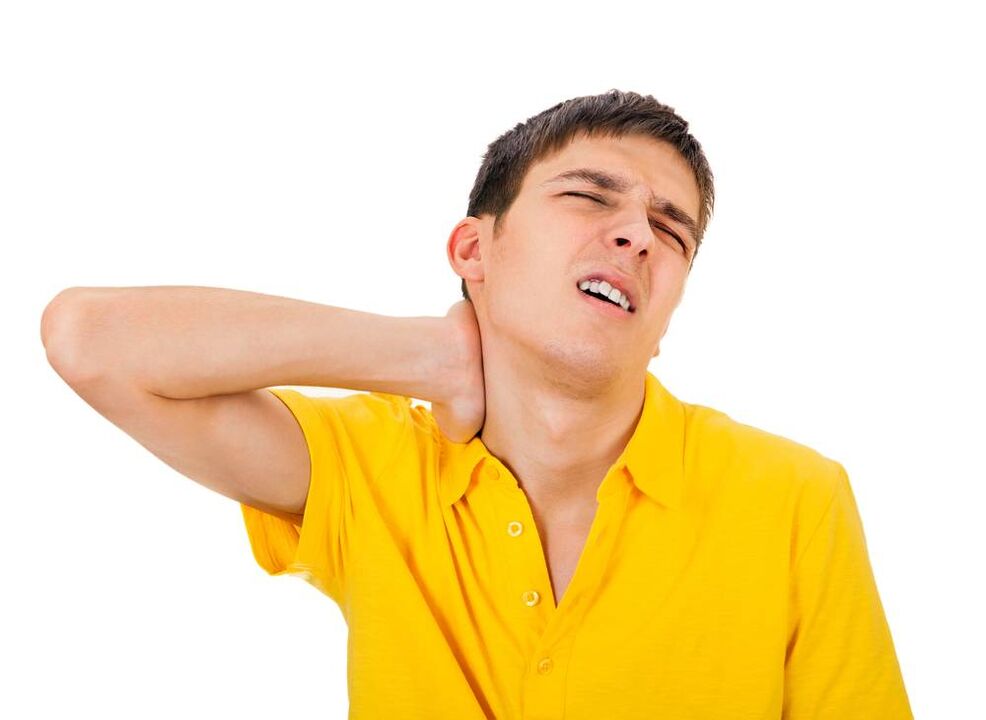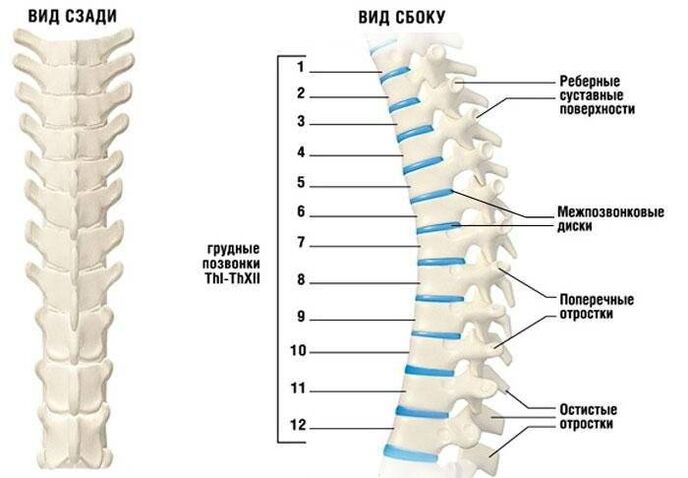Currently, according to medical statistics, almost all people over 25-30 years old are complaining about the symptoms of cervical osteocondrosis.The disease affects this spine more often than others.Pathology is a progressive degenerative process that affects intervertebral disks and vertebrae located in the neck.The disease is common among men and women the same.This is a dangerous and complex form of osteocondrosis, as large blood vessels that supply the brain and a large number of nerve endings are located in the neck.Violations of innerving and blood flow lead to deterioration in the brain to oxygen and nutrients.

Signs of the disease
Symptoms of osteochondrosis of cervical spine are more pronounced than in other parts of the spine, even with minor damage.This is because the vertebrae in the neck are located close to each other and the intervertebral disks have a small height.Such anatomical function contributes to the fact that with osteocondrosis, nerve endings, spinal cord, blood vessels more often compressed.
General Symptoms:
- pain syndrome;
- Weakness and decrease in sensitivity in the upper extremities;
- Limitation of neck mobility;
- violations of coordination of movements;
- Frequent dizziness;
- General weakness;
- Deterioration of the function of the organs of perception (hearing, vision, touch, taste).
The pain is more often located in the neck, gives them the back of the head, shoulders, arms.The upper limbs hurt if the nervous spine is squeezed by the damaged vertebra, which is responsible for their innerving.The pain on the back of the head is caused by spastic contractions of the neck muscles attached to the occipital bones and a violation of blood circulation in this area.
The weakness of the hands is observed in patients if the nervous spine is involved in the pathological process that ensures the innervation of muscle structures in the upper limbs.The restoration of mobility and a characteristic crunch when the neck is turned or tilted occurs if bone growth appears on the vertebrae of the cervix, is the height of the intervertebral disks reduced, the joints between the vertebrae are affected.
The vertebrae of the neck have transverse processes that form a channel where the artery that feeds the brain drivers.With osteocondrosis of the spine of the cervix, the vertebrae are offset, connective tissue grows on them.This leads to the compression of the cervical artery, a deterioration of the blood supply to the cerebellum and the back of the brain.As a result, a person has frequent dizziness, coordination of movements, general weakness is disturbed.In advanced cases, if the artery is involved in the pathological process or severely pushed, the supply of cerebellum blood, the occipital part and the brain stem is significantly worsened.In this case, the functionality of the consultation and the organs of the vision, the numbness of the tongue and the fingers is reduced.
Signs of the disease depend on which of the eight vertebrae is affected by a dystrophic or inflammatory process.Disorders of sensitivity and movement lead to damage to the cerebrospinal roots that certain vertebrae affect.Depending on this, the following manifestations of cervical osteocondrosis are observed:

- The first vertebra - the neck and the occipital part of the head are numb, their sensitivity falls;
- The other - pain in the crown and nape is felt;
- The third - pain is felt and the sensitivity is reduced in the part of the neck where the squeezed spinal cord is located, the intensity of flavors is reduced and speech inhibitions are present;
- The fourth - pain radiates in the shoulder, scapula, the patient is disturbed by heart pain, respiratory disorders and the tone of the muscles of the neck fall;
- Fifth - Pain is observed in the neck, given to the outer surface of the shoulder;
- The sixth - pain in the neck is radiated into the shoulder blade, feels in the forearm and thumb;
- Seventh - Pain is given to the shoulder blade, the back of the shoulder, forearm and fingers (from the other to the fourth);
- The eighth - pain spread from neck to shoulders, forearms and little fingers.
Depending on the occurrence of the lesion, four degrees of osteochondrosis of cervical spine separates.This is not the stage of the disease, but the severity of symptoms due to how common the pathological process is what the vertebrae it affects.
- In the first degree, clinical symptoms are absent or manifested minimally.Patients complain of slight pain and intensify during the movements of the head.The treatment that has begun at this stage of the disease will be effective.However, people often ignore disturbing symptoms or do not feel them, so they do not consult a doctor.
- The worsening of the pathological process improves the symptoms.In the second phase, pain becomes more pronounced, giving to the upper limbs, shoulder blades.At this step in the development of the degenerative process, the height of the intervertebral disc is reduced, as a result of the nerve fiber being squeezed.This will be the cause of increasing pain.The second degree of osteocondrosis in the cervical region is characterized by the appearance of headaches, a deterioration of well -development, a decrease in work ability.
- The third degree of cervical osteocondrosis is characterized by the formation of a hernia of the affected intervertebral disk.The mobility of the neck is limited, with palpation, the patient feels severe pain.With this spread of the pathological process, pain becomes constant and radiates to the upper limbs.The tension of the muscles attached to the occipital bones is felt.Patients complain of frequent dizziness, general weakness, numbness in the hands.
- The fourth degree of cervical osteocondrosis is diagnosed when the intervertebral disk is completely destroyed by a dystrophic process.It is replaced by fibrous tissue that leads to a significant limitation of mobility.The spinal cord and blood vessels flying in the neck are affected.Such changes are characterized by a significant deterioration of the blood supply to the cerebellum and brain occipital.Oxygen -Sult leads to a violation of coordination of movements, hearing reduction, vision, language, speech disorders.
Treatment methods
Timely, a doctor seeks when the first alarming symptoms appear, unpleasant sensations in the neck, reaction from the nervous system prevents the development of degenerative changes.Treatment of cervical osteocondrosis consists of a complex of therapeutic measures.Among them:
- To take medicine;
- massage;
- Physiotherapy Physical Education;
- Physiotherapeutic procedures.
Drug therapy
Doctors prescribe anti -inflammatory drugs to reduce the intensity of pain, reduce the inflammatory process and swelling of nervous spine.Chondroprotectors restore damaged cartilage tissue on the intervertebral disk.Musorelaxants relax the muscles of the neck, relieving the crumb.Medicine to improve blood flow helps resume weakened blood supply to the brain.B vitamins activate metabolism in nerve tissue.With intense pain, the doctor can prescribe painkillers.If the patient has a pronounced pain syndrome, painkillers are inserted parentrally after the pain is ATAB, they switch to tablets.
Physiotherapeutic methods
Physiotherapy is an effective way of fighting osteocondrosis in the cervical region.It is imperative to treat this disease using such techniques and the following results are obtained:
- The intensity of pain decreases;
- Recovering the affected bone, cartilage tissue is activated;
- Spasm and tension in the muscles are removed;
- An inflammatory process is stopped;
- The delivery of oxygen and nutrients to the affected area and the brain is improved.
The most effective for treating osteocondrosis is the following types of procedures:
- Drug electrophoresis (the affected area works with electric shock, which, in addition to activating blood flow and restoration of the tissues, improves the delivery of the functioning substance of the drug to the tissues affected by degenerative process);
- Ultrasound therapy (metabolic processes in the sick area are activated, pain decreases, inflammation is stopped);
- Magnetotherapy (relieves swelling from the affected area, which helps reduce the intensity of pain);
- Laser therapy (improves blood circulation in the pathological process, has an anti -inflammatory effect).
Medical physical exercise
Exercises are prescribed during the period when acute manifestations of the disease are stopped.During gymnastics should not be felt discomfort and tenderness.The complex must be performed by reaching a sustained remission to prevent relapse.

- Take a position lying on your stomach, lift your head and body, lean on your hands.The back is straight, the spirit is deep and even.Solve in a position for a minute or two, then slowly take the starting position.The number of repetitions is 3.
- The position lies on the stomach, hands along the body.Slowly turn your head and try to touch your ear on the floor.Repeat 6 times on each side.
- Sitting or standing, tilting your head on an inhalation and trying to reach your chin to your chest.On exhalation, smooth your head back and lift your eyes to the ceiling.The number of repetitions is 10-15.
- A good exercise to strengthen the cervical muscles is to squeeze the forehead against the hands pressed into it.To achieve the effect, press the palms on the forehead and forehead on the palm for 30 seconds.Repeat three times.
- Turn your head into a circle.Make the exercise slowly, smooth.In each direction - 10 turns each.The incidence of dizziness during movements is unacceptable.If this happens, stop immediately.
Massage
The course is prescribed by a physician during the absence of acute pain, only a specialist with a medical education can perform it.With such a disease, it is not recommended to contact non -professional.
Therapeutic effects of massage of the collar area:
- The blood stream and lymph in the affected area are improved;
- Muscles relax, spasms are removed;
- The intensity of pain decreases.
Surgical intervention
The action appears if conservative therapy does not bring results within six months, the patient is plagued by severe pain, signs of injury to nerve fibers and myelopathy are observed.If osteocondrosis in the cervix continues with complications, there is a threat of a stroke that is a strong squeeze of the spinal cord, then the operation is necessary.
According to the indications, they are going to the following types of surgical interventions:
- Endoscopic Discoctomy - Removal of Part or a whole intervertebral disk;
- Laminotomy - Excision of bone and overwested particles of bone tissue (often combined with laminoplasty - the establishment of artificial plates to expand the spinal canal);
- Laser evaporation of the slice core - the decomposition of the nucleus of the intervertebral slice with a laser beam at the same time as the destruction of its broken fragments;
- Cold -Plasma -nucleoplasty -The site of an endoscope is used a long and thin hole needle inserted into the intervertebral disc, comes an electrode that has a cold -covered effect through it to the destruction site.
The neck is a complex organ where large blood vessels, spinal cord pass.They are easy to harm, so they go for surgery in a maximum of 5% of cases.Surgical treatment is often accompanied by the development of complications.Among them:
- Inflammatory process in tissues or membranes in the spinal cord;
- Osteomyelitis;
- The formation of scars leading to a narrowing of arterial and spinal cords.
The operation of the cervical ridge is complex and requires a long rehabilitation period.The restoration of the patient after surgery takes a period of six months or more.
Prevention
To prevent the development of cervical osteocondrosis, it is necessary:
- monitor the location of the spine and neck;
- Led an active lifestyle, move more;
- When performing physical exercises, it is necessary to be careful and observe the correction of the performance, as even minor damage can affect the condition of the musculoskeletal system;
- Take care of the correct location of the body during sleep, buy an orthopedic or anatomical mattress;
- Equipment a workplace correctly where a person spends a lot of time;
- Participates regularly in physical culture;
- Monitor the diet, make sure all useful minerals needed for the bone fortress, especially magnesium and calcium;
- Reviews constant Dispensary studies for timely detection of osteochondrosis.
Prevention will help prevent degenerative changes in the cervix, protects against pain, dizziness, numbness in the limbs and other unpleasant symptoms.

















































